Seven games that effectively teach real orbital physics include Kerbal Space Program with its authentic rocket building, SpaceEngine’s scientifically accurate universe, Orbiter’s high-fidelity flight simulation, Children of a Dead Earth’s Newtonian combat, Universe Sandbox’s gravitational experiments, Simple Rockets 2 for mobile learning, and Celestia’s open-source visualization. You’ll gain practical understanding of orbital mechanics, thrust-to-weight ratios, and gravitational interactions through engaging gameplay. Discover how these simulations can transform complex physics into intuitive knowledge.
Kerbal Space Program: Rocket Science Made Accessible
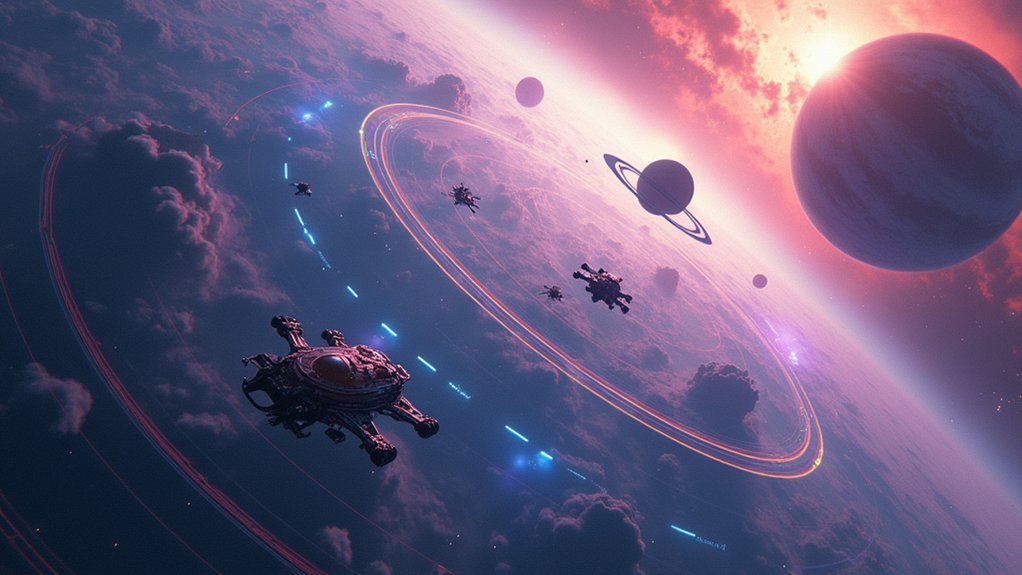
While professional rocket scientists rely on complex mathematical models, Kerbal Space Program makes orbital physics accessible to anyone with a computer and curiosity.
You’ll engage with authentic Newtonian dynamics as you design rockets and plan missions, learning critical concepts like thrust-to-weight ratios and the rocket equation through hands-on experimentation.
When your spacecraft fails—and it will—you’ll refine your approach, applying what you’ve learned to overcome challenges.
This trial-and-error process builds intuitive understanding of complex spaceflight principles, from gravitational assists to orbital inclination changes.
You’ll master the art of calculating fuel requirements and timing orbital maneuvers perfectly.
The game’s engaging format transforms abstract orbital mechanics into visual, practical knowledge—you’re not just memorizing formulas, you’re experiencing the physics that govern real-world spaceflight.
Spaceengine: Exploring the Universe With Realistic Orbits
SpaceEngine shifts the focus from Kerbal’s hands-on rocket building to a vast, scientifically accurate universe waiting to be explored.
You’ll travel across billions of light-years through procedurally generated galaxies while experiencing precise orbital mechanics that mirror real cosmic behavior.
The software’s time manipulation features let you witness celestial phenomena unfold—from planetary rotations to galactic movements—enhancing your understanding of gravitational interactions in space.
As you navigate this virtual cosmos, the built-in Wiki provides detailed astronomical data about each object you encounter.
Whether you’re a casual space enthusiast or serious student of astronomy, SpaceEngine delivers an educational space exploration platform that demonstrates complex orbital physics in an accessible format, allowing you to observe and interact with realistic cosmic systems firsthand.
Orbiter: High-Fidelity Space Flight Simulation
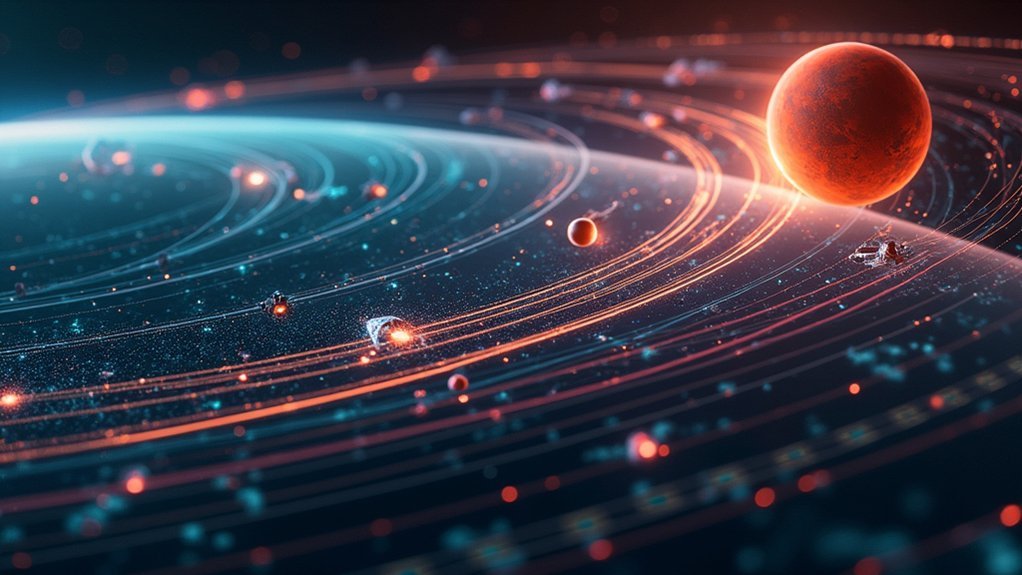
You’ll master authentic spacecraft controls in Orbiter, where every thruster and navigation system mimics real-world counterparts with impressive accuracy.
The simulation’s stunning celestial mechanics reveal the beauty of orbital dynamics as you execute precise Hohmann transfers and gravitational slingshots.
Orbiter’s physics engine calculates n-body gravitational interactions in real-time, creating a learning environment where your successes feel genuinely earned through applied orbital mathematics.
Authentic Spacecraft Controls
Rarely does a space simulation offer the level of authentic control that Orbiter provides to aspiring astronauts and physics enthusiasts.
You’ll command spacecraft using systems modeled after real-world flight controls, managing complex flight dynamics with precision that mirrors actual spaceflight operations.
The interface equips you with thorough orbital displays and trajectory indicators that visualize your spacecraft’s path through space.
You’ll execute genuine orbital mechanics maneuvers—Hohmann transfers, precision rendezvous, and docking procedures—all while monitoring realistic fuel consumption calculations.
From launch sequences to orbit insertion and landing protocols, every procedure follows authentic guidelines used by space agencies like NASA.
This focused experience doesn’t simplify the physics for gameplay; instead, it challenges you to master the intricate control systems that govern actual spacecraft navigation in the cosmos.
Stunning Celestial Mechanics
While many space games simplify physics for accessibility, Orbiter stands apart with its meticulously crafted n-body gravitational system that models the complex dance of celestial objects. You’ll experience authentic orbital dynamics as you plan intricate Hohmann transfers between planets.
| Orbital Feature | Physics Simulation | Player Experience |
|---|---|---|
| Gravitational pulls | N-body physics engine | Realistic trajectory planning |
| Planetary motion | Accurate celestial mechanics | Strategic fuel management |
| Spacecraft momentum | Thrust-to-weight calculations | Challenging course corrections |
| Orbital decay | Environmental factors | Mission contingency planning |
| Transfer windows | Time-dependent opportunities | Authentic mission timing |
The community-created add-ons enhance these physics simulations, letting you tackle increasingly complex scenarios. You’ll gain genuine insights into astrophysics while mastering the delicate art of maneuvering through the void between worlds.
Children of a Dead Earth: Combat With Newtonian Physics
In Children of a Dead Earth, you’ll face the brutal reality of space combat where Newton’s laws govern every aspect of your strategy.
You’ll need to calculate exact trajectories for your weapons while managing complex propulsion systems that obey conservation of momentum and energy.
Your success hinges on mastering these realistic physics constraints, from planning efficient Hohmann transfers to engineering spacecraft that can effectively deliver kinetic energy to targets.
Realistic Combat Mechanics
Unlike arcade-style space shooters, “Children of a Dead Earth” stands apart with its commitment to scientific accuracy in space combat.
You’ll need to master orbital mechanics as you calculate trajectories and plan attacks with real-world physics dictating every movement.
Your ship doesn’t instantly respond to controls—inertia and momentum matter. When you fire weapons or change course, you’re working against your current velocity in the vacuum of space. Each customization decision affects your spacecraft’s mass and performance, creating genuine spaceflight challenges.
Success requires strategic thinking: planning your approach vectors, utilizing gravitational assists, and positioning for ideal firing angles.
There’s no aerial-style dogfighting here—you’re managing complex physics calculations while engaging enemies. The game transforms these realistic limitations into compelling gameplay that rewards patience and tactical foresight.
Propulsion System Challenges
Mastering propulsion systems in “Children of a Dead Earth” demands a genuine understanding of physics that most space games simply ignore.
You’ll need to calculate ideal burn times and manage your thrust-to-weight ratio with precision—factors that directly impact your spacecraft’s acceleration and maneuverability in the vacuum of space.
Unlike arcade-style space games, you can’t simply point and go.
Every maneuver requires strategic planning, accounting for your vessel’s inertia and available fuel.
The game’s commitment to Newtonian physics means you’ll face the authentic challenges of orbital mechanics, from gravitational assists to complex trajectory planning for interplanetary travel.
Universe Sandbox: Experimenting With Gravitational Systems
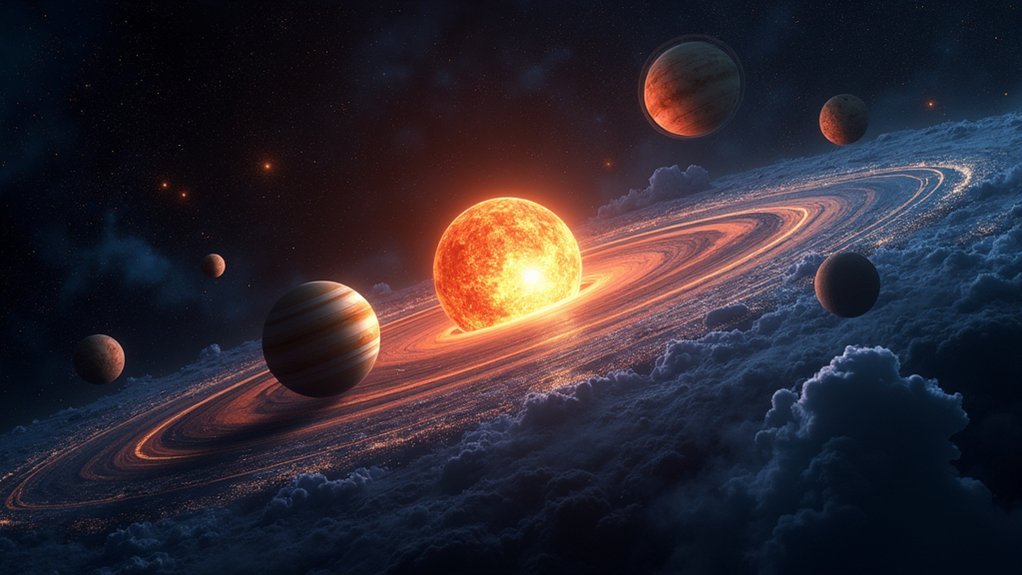
While many space games simplify orbital mechanics, Universe Sandbox stands apart as a powerful physics simulator that puts gravitational interactions at your fingertips.
Using Newtonian mechanics, it allows you to observe how mass and distance influence orbital motion in real time.
You’ll experiment with N-body dynamics, creating complex gravitational systems where multiple objects interact simultaneously.
Want to understand orbital stability? Create your own solar system by adjusting mass, velocity, and distance parameters.
The software’s real-time engine lets you witness long-term evolution of these systems, including orbital decay and perturbation effects.
Perhaps most dramatically, you can orchestrate planetary collisions to see how such cataclysmic events alter existing orbits and spawn new celestial phenomena like supernovae—providing intuitive understanding of concepts that might otherwise remain abstract.
Simple Rockets 2: Mobile Orbital Mechanics for Beginners
For those intimidated by complex physics simulators, Simple Rockets 2 offers an accessible entry point into orbital mechanics that doesn’t sacrifice scientific accuracy. The game’s user-friendly interface simplifies spaceflight concepts while still delivering authentic physics principles.
You’ll design rockets and experiment with thrust, drag, and gravity through hands-on trial and error. The realistic physics engine helps you visualize orbital dynamics including Hohmann transfers and rendezvous techniques—fundamental concepts in actual spaceflight planning.
Mission scenarios challenge you to apply efficient fuel management and precise trajectory calculations, skills that mirror real-world orbital mechanics problems.
As you iterate on your designs to achieve successful launches and landings, you’ll develop intuitive understanding of physics principles through creative problem-solving rather than abstract formulas.
Celestia: Open-Source Space Visualization With Real Physics
Unlike traditional games, Celestia offers a physics-accurate window into the cosmos through its open-source simulation platform.
You’ll experience the universe at varying speeds while observing how orbital mechanics govern celestial body movements with remarkable precision.
Celestia’s extensive database lets you explore real astronomical phenomena or design your own spaceflight scenarios. You can witness how gravity affects spacecraft trajectories and planetary orbits while maintaining scientific accuracy.
Experience the dance of gravity on spacecraft and planets through Celestia’s scientifically-precise simulation tools.
The software’s strength lies in its community-driven approach, allowing you to create and share custom content from new solar systems to detailed spacecraft models.
Whether you’re studying orbital mechanics or simply curious about space, Celestia functions as both a powerful educational tool and an engaging astronomical visualization platform that puts realistic space exploration at your fingertips.
Frequently Asked Questions
What Is the Most Realistic Spaceflight Simulator?
Kerbal Space Program offers you the most realistic spaceflight simulation experience. You’ll learn fundamental orbital mechanics and rocket equation concepts through hands-on gameplay that balances scientific accuracy with accessibility.
What Is the Space Simulation Game Called?
You’re asking about a space simulation game, but there are several I mentioned: Kerbal Space Program, Orbiter, Universe Sandbox, FOSSPioneer, and SpaceEngine. Each offers unique features for experiencing orbital physics and space exploration.
What’s the Best Space Exploration Game?
You’ll find Kerbal Space Program is widely considered the best space exploration game. It allows you to design rockets, manage missions, and learn actual orbital mechanics while providing an engaging, hands-on experience.
What Is the Game That Lets You Explore the Universe?
SpaceEngine lets you explore the universe in incredible detail. You’ll travel between stars and galaxies across billions of light-years, experiencing both real and procedurally generated celestial objects with scientifically accurate representations.
In Summary
You’ve now discovered seven games that can transform complex orbital physics into an engaging experience. Whether you’re launching rockets in Kerbal Space Program or simulating cosmic collisions in Universe Sandbox, these games offer more than entertainment—they’re gateways to understanding the fundamental laws governing our universe. Next time you’re exploring these virtual spaces, you’ll be learning real science with every orbit, maneuver, and gravitational interaction.
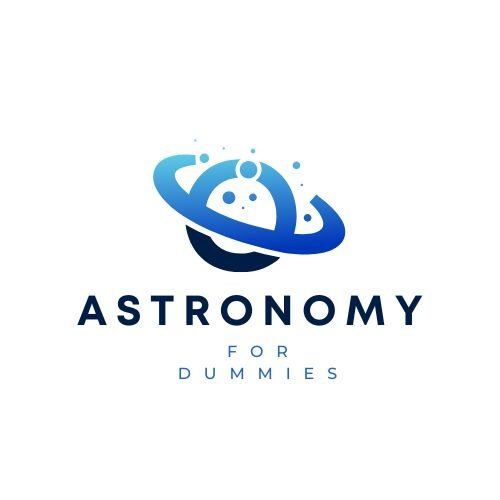



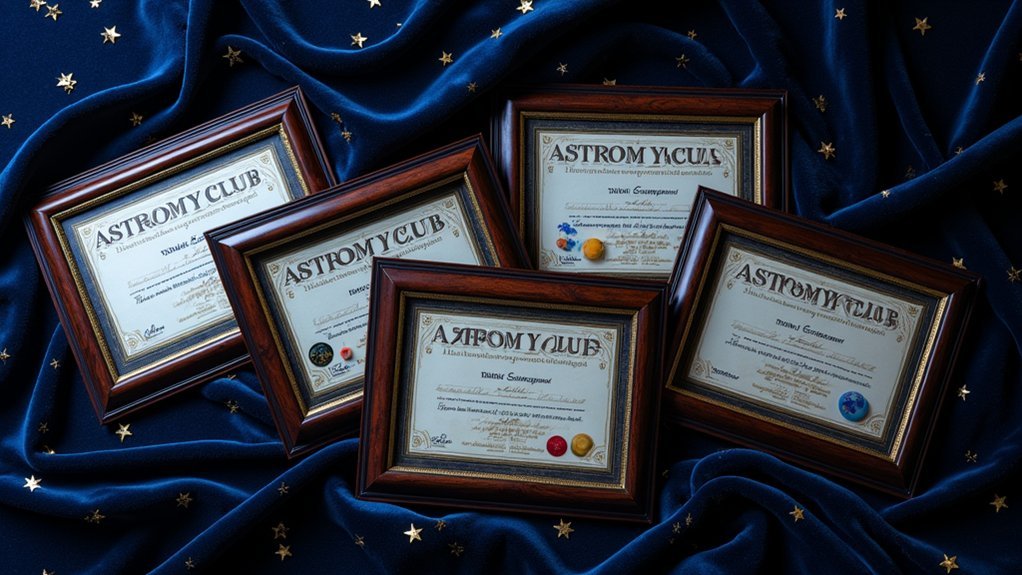
Leave a Reply